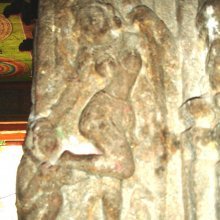Thorn: 2 definitions
Introduction:
Thorn means something in Hinduism, Sanskrit. If you want to know the exact meaning, history, etymology or English translation of this term then check out the descriptions on this page. Add your comment or reference to a book if you want to contribute to this summary article.
Images (photo gallery)
In Hinduism
Natyashastra (theatrics and dramaturgy)
Source: Shodhganga: Elements of Art and Architecture in the Trtiyakhanda of the Visnudharmottarapurana (natya)Thorn or Splinter Extraction is associated with the Agraja variety of Sandaṃśahasta: one of the twenty-two Single-hand Gestures (in Indian Dramas) (known as asaṃyuktahastas), according to the Viṣṇudharmottarapurāṇa, an ancient Sanskrit text which (being encyclopedic in nature) deals with a variety of cultural topics such as arts, architecture, music, grammar and astronomy.—The word sandaṃśa means kaṅkamukha i.e., a pair of tong. Tong is a kind of tool which is used to hold something. [...] The Viṣṇudharmottarapurāṇa speaks of three kinds this form viz., agraja, mukhaja and pārśvakṛta and it gives detailed discussion of the usages of each one clearly. The agraja-sandaṃśa-hasta is used for holding and extraction of thorns or splinters.

Natyashastra (नाट्यशास्त्र, nāṭyaśāstra) refers to both the ancient Indian tradition (shastra) of performing arts, (natya—theatrics, drama, dance, music), as well as the name of a Sanskrit work dealing with these subjects. It also teaches the rules for composing Dramatic plays (nataka), construction and performance of Theater, and Poetic works (kavya).
Yoga (school of philosophy)
Source: ORA: Amanaska (king of all yogas): A Critical Edition and Annotated Translation by Jason BirchThe Thorn (that is the mind) is denoted by the Sanskrit term Śalya, according to the Amanaska Yoga treatise dealing with meditation, absorption, yogic powers and liberation.—Accordingly, as Īśvara says to Vāmadeva: “[...] When the thorn that is the mind (manaḥ-śalya) is dislodged by the natural, no-mind [state], the body becomes loose [and collapses] like a large umbrella without its pole. When the thorn of mental-faculties has been uprooted, roots and all, by means of the no-mind spade, the sage becomes happy. [...]”.

Yoga is originally considered a branch of Hindu philosophy (astika), but both ancient and modern Yoga combine the physical, mental and spiritual. Yoga teaches various physical techniques also known as āsanas (postures), used for various purposes (eg., meditation, contemplation, relaxation).
See also (Relevant definitions)
Starts with (+3): Thorn apple, Thorn orache, Thorn randia, Thornless thistle, Thornveld taaibos, Thorny acacia, Thorny amaranth, Thorny bone-apple, Thorny burr, Thorny coral tree, Thorny dadap, Thorny feather-wattle, Thorny flower of the panya, Thorny hog-plum, Thorny ivy-rue, Thorny karree, Thorny locust, Thorny pigweed, Thorny pisonia, Thorny poppy.
Ends with (+74): Alder buckthorn, Alderleaf buckthorn, Biltmore hawthorn, Birch-leaf buckthorn, Black hawthorn, Black-thorn, Blackthorn, Buckthorn, Buffalo thorn, California buckthorn, Camel thorn, Cape thorn, Carolina buckthorn, Cascara buckthorn, Cat-thorn, Catch thorn, Chaparral whitethorn, Christ-thorn, Cockspur thorn, Columbia hawthorn.
Full-text (+757): Kantaka, Nishkantaka, Shalya, Akantaka, Dhustura, Dhattura, Sashalya, Vishalya, Sakantaka, Dalasuci, Kantakoddharana, Kantakamarddana, Vikantaka, Shitagra, Vankila, Rankala, Krishnadhattura, Nihshalya, Kahalapushpa, Hemataru.
Relevant text
Search found 198 books and stories containing Thorn; (plurals include: Thorns). You can also click to the full overview containing English textual excerpts. Below are direct links for the most relevant articles:
Brihad Bhagavatamrita (commentary) (by Śrī Śrīmad Bhaktivedānta Nārāyana Gosvāmī Mahārāja)
Verse 2.2.222 < [Chapter 2 - Jñāna (knowledge)]
Verse 2.4.242 < [Chapter 4 - Vaikuṇṭha (the spiritual world)]
Verse 1.6.44 < [Chapter 6 - Priyatama (the most beloved devotees)]
Saying 45 - Grapes Do Not Come From Thorns
Saying 9 - A Parable Of A Sower
Manusmriti with the Commentary of Medhatithi (by Ganganatha Jha)
Verse 9.252 < [Section XXXV - Consolidation and Settlement of the Kingdom]
Verse 9.292 < [Section XXXVIII - Treatment of Criminals and their Punishment]
Verse 2.47 < [Section XIII - Initiation (upanayana)]
Garga Samhita (English) (by Danavir Goswami)
Verse 3.10.6 < [Chapter 10 - The Glory of Śrī Girirāja]
Verse 5.17.6 < [Chapter 17 - The Gopis Describe Their Remembrance of Sri Krsna]
Yoga-sutras (with Bhoja’s Rajamartanda) (by Rajendralala Mitra)
Sūtra 3.39 < [Third Chapter (Vibhuti Pada)]
"The Thorn that did not Stick" < [October-December 1942]
Martial Dissonance in R. P. Jhabvala’s The < [July – September, 2007]
A Scar < [July – September, 1993]

